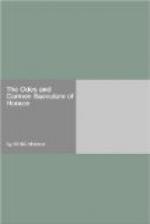tu, Melpomene.” For this I took a different
metre, which happens to be identical with that of a
solitary Ode in the Second Book, “Non ebur neque
aureum,” being guided still by my feeling about
the individual Ode, not by any more general considerations.
I did not attempt a third until I had proceeded sufficiently
far in my undertaking to see that I should probably
continue to the end. Then I had to consider the
question of a uniform metre to answer to the Latin.
Both of those which I had already tried were rendered
impracticable by a double rhyme, which, however manageable
in one or two Odes, is unmanageable, as I have before
intimated, in the case of a large number. The
former of the two measures, divested of the double
rhyme, would, I think, lose most of its attractiveness;
the latter suffers much less from the privation:
the latter accordingly I chose. The trochaic character
of the first line seems to me to give it an advantage
over any metre composed of pure iambics, if it were
only that it discriminates it from those alternate
ten-syllable and eight-syllable iambics into which
it would be natural to render many of the Epodes.
At the same time, it did not appear worth while to
rewrite the two Odes already translated, merely for
the sake of uniformity, as the principle of correspondence
to the Latin, the alternation of longer and shorter
lines, is really the same in all three cases.
Nay, so tentative has been my treatment of the whole
matter, that I have even translated one Ode, the third
of Book I, into successive rather than into alternate
rhymes, so that readers may judge of the comparative
effect of the two varieties. After this confession
of irregularity, I need scarcely mention that on coming
to the Ode which had suggested the metre in its unmutilated
state, I translated it into the mutilated form, not
caring either to encounter the inconvenience of the
double rhymes, or to make confusion worse confounded
by giving it, what it has in the Latin, a separate
form of its own.
The remaining metres may be dismissed in a very few
words. As a general rule, I have avoided couplets
of any sort, and chosen some kind of stanza.
As a German critic has pointed out, all the Odes of
Horace, with one doubtful exception, may be reduced
to quatrains; and though this peculiarity does not,
so far as we can see, affect the character of any
of the Horatian metres (except, of course, those that
are written in stanzas), or influence the structure
of the Latin, it must be considered as a happy circumstance
for those who wish to render Horace into English.
In respect of restraint, indeed, the English couplet
may sometimes be less inconvenient than the quatrain,
as it is, on the whole, easier to run couplet into
couplet than to run quatrain into quatrain; but the
couplet seems hardly suitable for an English lyrical
poem of any length, the very notion of lyrical poetry
apparently involving a complexity which can only be
represented by rhymes recurring at intervals.




